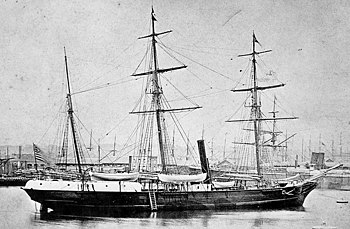
Back Expedició Jeannette Catalan Americká arktická expedice Czech Jeannette-ekspeditionen Danish Expedición Jeannette Spanish Expédition Jeannette French Expedição Jeannette Portuguese Экспедиция на «Жаннетте» Russian

The Jeannette expedition of 1879–1881, officially called the U.S. Arctic Expedition, was an attempt led by George W. De Long to reach the North Pole by pioneering a route from the Pacific Ocean through the Bering Strait. The premise was that a temperate current, the Kuro Siwo, flowed northwards into the strait, providing a gateway to the hypothesized Open Polar Sea and thus to the pole.
This theory proved illusory; the expedition's ship, USS Jeannette and its crew of thirty-three men, was trapped by ice and drifted for nearly two years before she was crushed and sunk north of the Siberian coast. De Long then led his men on a perilous journey by sled, dragging the Jeannette's whaleboat and two cutters, eventually switching to these small boats to sail for the Lena Delta in Siberia. During this journey, and in the subsequent weeks of wandering in Siberia before rescue, twenty of the ship's complement died, including De Long.
The chief exponent of the theory of a warm-water gateway to the North Pole was the German cartographer August Petermann. He encouraged James Gordon Bennett Jr., the proprietor of The New York Herald, to finance a polar expedition based on the untried Pacific route. Bennett acquired a former Royal Navy gunboat, Pandora, and changed her name to Jeannette. De Long, whom Bennett chose to lead the expedition, was a serving United States Navy officer with previous Arctic experience. Although essentially a private venture, in which Bennett paid all the bills, the expedition had the full support of the U.S. government. Before departure the ship was commissioned into the U.S. Navy as USS Jeannette, and sailed under navy laws and discipline.
Before its demise, the expedition discovered new islands—the De Long Islands—and collected valuable meteorological and oceanographic data. Although Jeannette's fate demolished the widely believed Open Polar Sea theory, the appearance in 1884 of debris from the wreck on the south-west coast of Greenland indicated the existence of an ocean current moving the permanent Arctic ice from east to west. This discovery inspired Fridtjof Nansen to mount his Fram expedition nine years later. A monument to the Jeannette's dead was erected at the United States Naval Academy in Annapolis, Maryland, in 1890.
© MMXXIII Rich X Search. We shall prevail. All rights reserved. Rich X Search